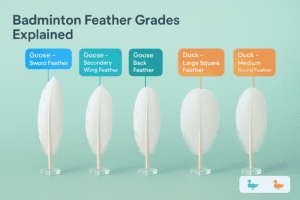The durability of badminton shuttlecocks, whether feather or synthetic, is a key factor for players at all levels, affecting both the quality of play and the cost-effectiveness of their equipment choices. Here’s a comparison of the durability aspects between feather and synthetic badminton shuttlecocks:
Feather Shuttlecocks
- Material and Construction: Feather shuttlecocks are made from natural duck or goose feathers, with goose feathers being thicker and offering better flight quality and durability[6].
- Durability Concerns: Despite the higher quality of materials, feather shuttlecocks are generally less durable than synthetic ones. They are prone to damage and breakage, especially if mishit, and cannot easily be repaired once a feather is broken or displaced[7].
- Environmental Conditions: Feather shuttlecocks’ durability can be somewhat extended by storing them in a humid environment, which prevents the feathers from becoming brittle and dry, leading to quicker breakage[2].
- Usage by Level of Play: They are typically used by intermediate to professional-level players due to their superior flight characteristics but have lower durability compared to nylon shuttles, making them less cost-effective for frequent use[2][3].
Synthetic (Nylon) Shuttlecocks
- Material and Construction: Made from nylon or other plastic materials, synthetic shuttlecocks are designed to be more durable than their feather counterparts[1][6].
- Durability Advantages: These shuttlecocks are praised for their fantastic durability, lasting for a long time, sometimes up to 100 games before wearing out[2]. This makes them a preferred choice for beginners, recreational, and lower-level club players.
- Cost-Effectiveness: Due to their durability, synthetic shuttlecocks offer a more cost-effective solution for players who are not competing at high levels or are just practicing[1][8].
- Performance Trade-offs: While they last longer, synthetic shuttlecocks do not offer the same flight characteristics as feather shuttlecocks, which can affect the quality of play and player development[1][4].
Conclusion
The choice between feather and synthetic shuttlecocks often comes down to a trade-off between performance and durability. Feather shuttlecocks provide a more authentic and high-quality playing experience but are less durable and more expensive in the long run due to the need for frequent replacements. On the other hand, synthetic shuttlecocks offer greater durability and are more cost-effective for casual play, practice, and beginners, but they do not mimic the flight characteristics of feather shuttlecocks as closely, which can impact the development of advanced badminton skills.
Citations:
[1] https://www.nydhi.com/blogs/news/feather-shuttlecocks-vs-nylon-shuttlecocks
[2] https://badmintonhq.co.uk/pages/badminton-shuttle-buying-guide
[3] https://www.sportsuncle.com/blog/article/feather-nylon-shuttlecock
[4] https://www.reddit.com/r/badminton/comments/10xcvo7/possibility_of_reducing_use_of_animal_product_in/
[5] https://www.youtube.com/watch?v=LWhFrbWlWM0
[6] https://yumo.ca/blogs/badminton-information/badminton-shuttles-feather-vs-nylon
[7] https://badmintonbites.com/shuttlecock-comparison/
[8] https://blog.decathlon.in/articles/plastic-shuttlecock-vs-feather-shuttlecock







